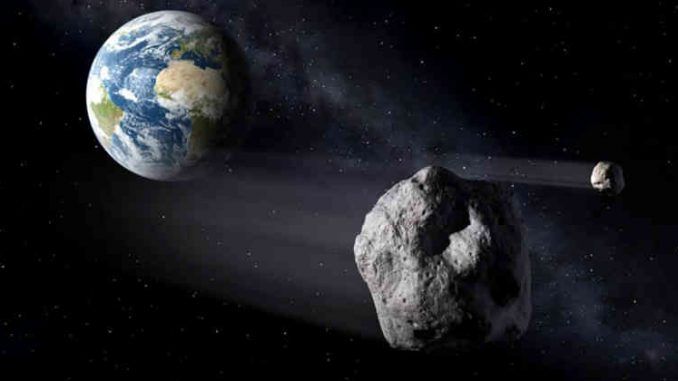
NASA has confirmed it is closely monitoring the approach of a huge asteroid, as a top scientist warns it is “coming in damn close” to Earth.
The asteroid, which is as big as a tower block and is traveling towards us at more than 40,000mph, has been named Asteroid 2012 TC4 and is expected to pass by earth so closely that satellites will be in danger.
Asteroid 2021 TC4 is believed to be bigger than the Chelyabinsk meteor which exploded above Russia, damaging thousands of buildings and injuring 1,500 people in 2013.

BYPASS THE CENSORS
Sign up to get unfiltered news delivered straight to your inbox.
You can unsubscribe any time. By subscribing you agree to our Terms of Use
The Express reports: NASA is convinced it will not impact, but say it will skim earth at a distance of about 27,300 miles. At one stage it was feared it could come as close as just over 4,000 miles.
Asteroid 2012 TC4 is estimated to be between 10 and 30 metres (30 and 100 feet) and will pass by earth on October 12.
The 20-metre Chelyabinsk meteor exploded in the atmosphere above the Russian city unexpectedly on February 15 2013.
No space agency had any idea it was approaching before the explosion ripped through the air.
The asteroid released around 26 to 33 times as much energy of the atomic bomb that was dropped on Hiroshima.
Most injuries sustained were from flying broken glass from buildings damaged by the strength of the explosion.
Nasa scientists are aware of the pass of the larger 2012 TC4 and said they were excited about what could be learned from it.
A spokesman said: “They plan to use its upcoming October close approach to earth as an opportunity not only for science, but to test Nasa’s network of observatories and scientists who work with planetary defence.
“Even though scientists cannot yet predict exactly how close it will approach, they are certain it will come no closer than 4,200 miles (6,800 kilometres) from the surface of earth.”
Michael Kelley, program scientist and Nasa Headquarters lead for the TC4 observation campaign, said: “Scientists have always appreciated knowing when an asteroid will make a close approach to and safely pass the earth because they can make preparations to collect data to characterise and learn as much as possible about it.
“This time we are adding in another layer of effort, using this asteroid flyby to test the worldwide asteroid detection and tracking network, assessing our capability to work together in response to finding a potential real asteroid threat.”

Scientists from Nasa’s Center for Near-Earth Object Studies (CNEOS) at the Jet Propulsion Laboratory in Pasadena, California, have determined that it could even pass much farther away, as far as 170,000 miles (270,000 kilometres), or two-thirds of the distance from Earth to the moon.
These calculations are based on only seven days of tracking 2012 TC4 after it was discovered on October 5, 2012, by the Panoramic Survey Telescope and Rapid Response System (Pan-STARRS) from Haleakala on the island of Maui, Hawaii.
Further observations are needed to more precisely determine the asteroid’s orbit, which has been out of range of telescopes since 2012.
The spokesman added: “Asteroid 2012 TC4 may be slightly larger than the space rock that hit Earth’s atmosphere near Chelyabinsk, Russia, in February 2013.
“As it starts to approach Earth this summer, large telescopes will be used to detect it and re-establish the asteroid’s precise trajectory.
“The new observations are expected to help refine knowledge about its orbit, narrowing the uncertainty about how far it will be from Earth at its closest approach in October.”
Paul Chodas, manager of the CNEOS at JPL said: “This is the perfect target for such an exercise because while we know the orbit of 2012 TC4 well enough to be absolutely certain it will not impact Earth, we haven’t established its exact path just yet.
“It will be incumbent upon the observatories to get a fix on the asteroid as it approaches, and work together to obtain follow-up observations than make more refined asteroid orbit determinations possible.”


